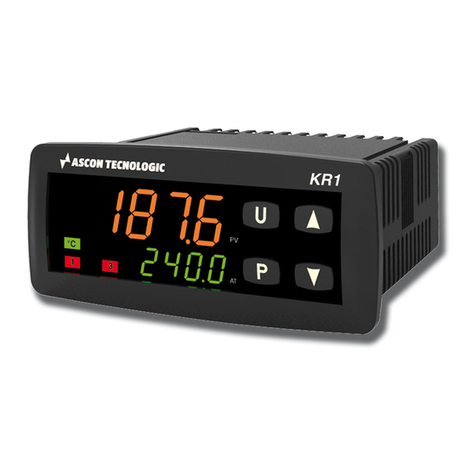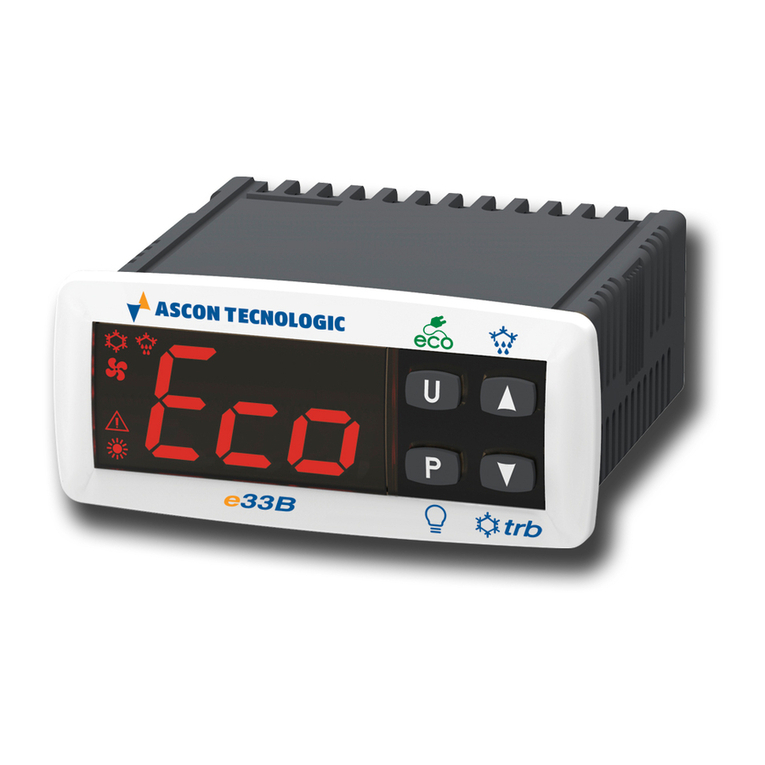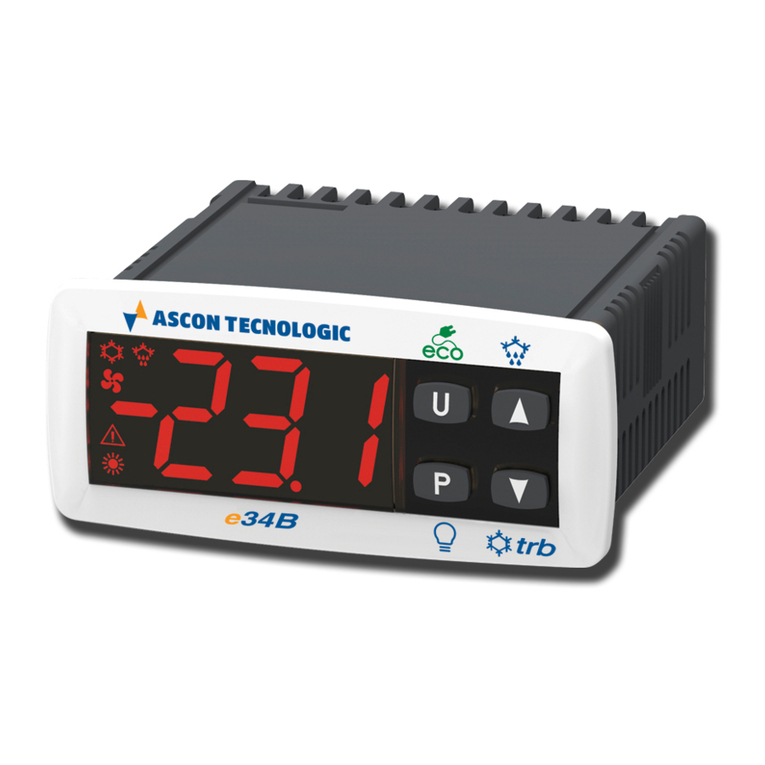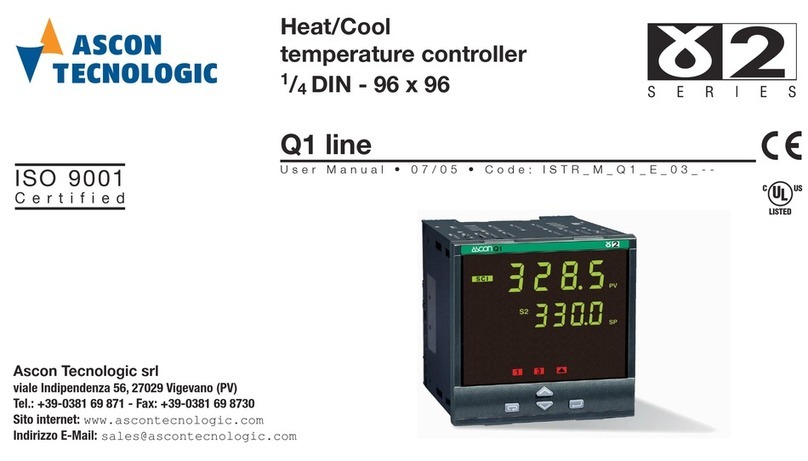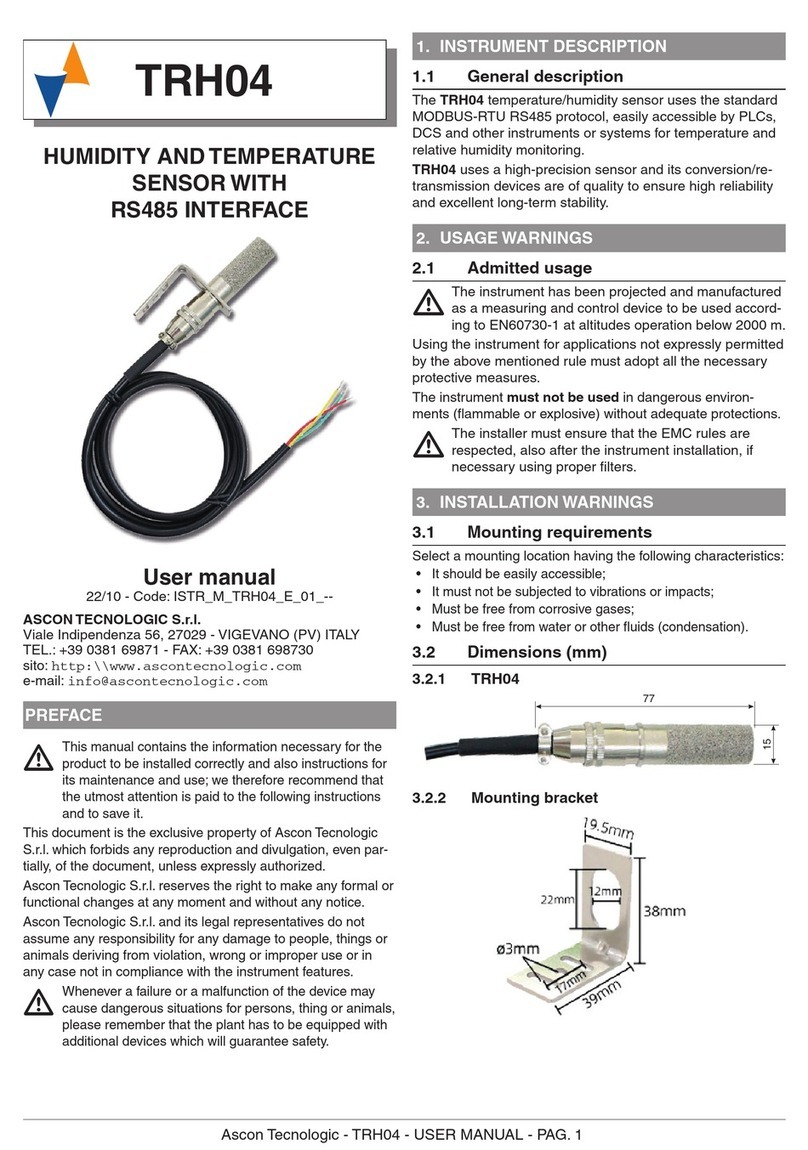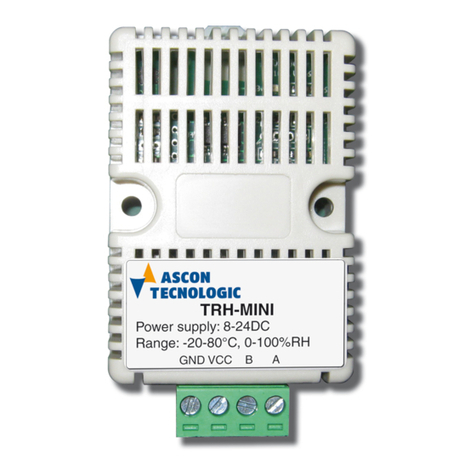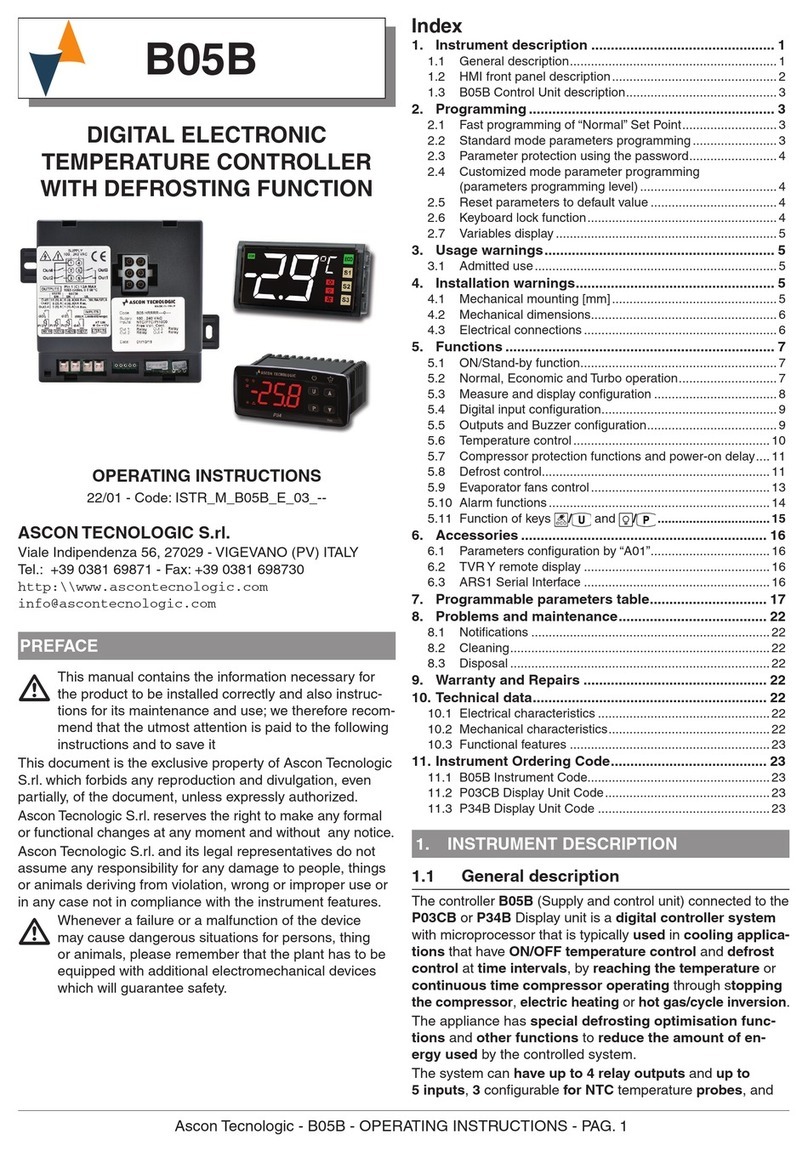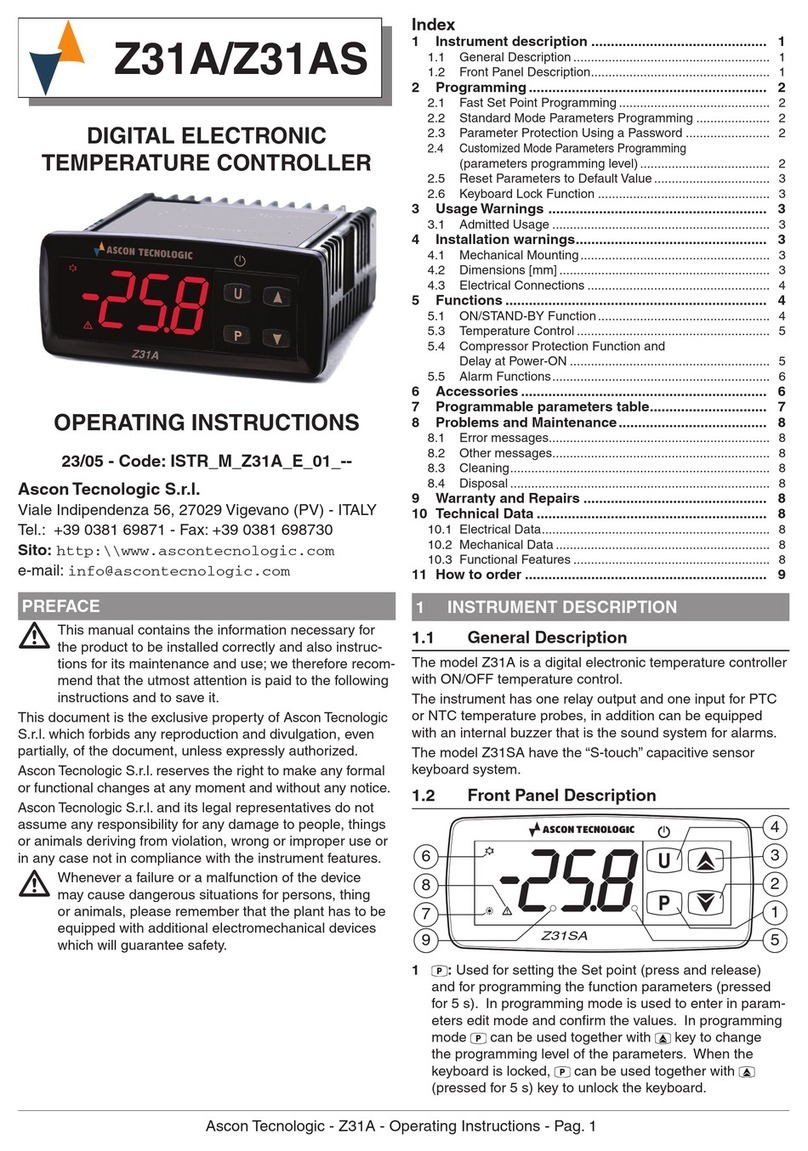
Ascon Tecnologic - e33 - OPERATING INSTRUCTIONS - PAG. 7
5.4 Digital input configuration
The digital input function (available on terminal 12 or instead
of Pr2 input if ip2 = dg) is defined using the iFi parameter
and the action is delayed for the time programmed with pa-
rameter iti. The iFi parameter can be configured for the
following functions:
0 Digital input not active;
1 Cell door opening with NO contact: at input closure (and
after the iti) the instrument alternately displays oP and the
variable set at idS parameter. This DI operation mode ac-
tivates also the time set with parameter AoA elapsed which
the alarm is activated to warn that the door has been left
open. In addition, at door opening, the instrument returns to
Normal operation if it was in Eco mode and the Eco mode
activation was enabled through parameter iEt;
2 Cell door opening with NO contact: Similar to iFi = 1
but with evaporator fans stop. In addition, at open door
alarm intervention (AoA), the fans are restarted;
3 Cell door opening with compressor and fan outputs lock
and NO contact: similar to iFi = 2but with compressor
and fans lock. At open door alarm intervention (AoA)
both the fans and the compressor are re-activated.
4 External alarm signal with NO contact: at input closing
(and after the iti time) the alarm is activated and the
instrument alternately shows on the display: AL and the
variable set with parameter idS;
5 External alarm signal with all control outputs disabled
and NO contact: at input closing (and after the iti time)
all the control outputs are disabled, the alarm is activated
and the instrument alternately shows on the display: AL
and the variable set with parameter idS;
6 Normal/Eco mode selection with NO contact: at input
clos-
ing (and after the iti time) the instrument switches to
Economic operation mode. Opening the digital input, the
instrument returns in Normal operation mode.
7 Instrument On/Off (stand-by) selection with NO contact:
at input closing (and after the iti time) the instrument
is switched ON while it is placed in Stand-by mode when
the digital input is open;
8 Turbo activation command with NO contact: at input
closing (and after the iti time) the instrument starts a
Turbo cycle;
9 Defrost activation command with NO contact: at input
closing (and after the iti time) the instrument starts a
defrost cycle;
10 End-Defrost command with NO contact: at input closing
(and after the iti time), if the defrost cycle is in progress
the instrument stops it, otherwise inhibits the defrost start;
-1... -10 - Features identical to the above but obtained
through a NC contact and a reversed logic operation.
5.5 Outputs and buzzer configuration
The instrument outputs can be configured by the relative pa-
rameters oo1, oo2 and oo3. The outputs can be configured
for the following functions:
ot To control
the temperature control device (e.g. Compres-
sor). To manage the cooling control device for neutral zone
control or Cooling/Heating (rHC = nr or HC);
df To control the defrosting device;
Fn To control the evaporator fans;
Au To control the auxiliary device;
At To control a silenceable alarm device through a contact
that is NO in normal operation then closed when the
alarm sounds;
AL To control an alarm that cannot be silenced through a
contact that is NO in normal operation then closed when
the alarm sounds;
An To control an alarm with a memory function through a
contact that is NO in normal operation then closed when
the alarm sounds (see alarm memory);
-t To control a silenceable alarm device through a contact
that is NC in normal operation then closed when the
alarm sounds;
-L Control an alarm that cannot be silenced through a con-
tact that is NC in normal operation then closed when the
alarm sounds;
-n To control an alarm with a memory function through a
contact that is NC in normal operation then closed when
the alarm sounds;
on To command a device that must be turned ON when the
instrument is ON. The output is therefore deactivated
when the instrument is not powered or is in standby
mode. This mode of operation can be used as a control
of the shop window lighting, anti-fogging resistors or
other utilities;
HE To control a heating device in neutral zone or Cooling/
Heating control mode (rHC = nr or HC);
oF Output disabled.
If one of the outputs is configured as auxiliary output (oo1/oo2/
oo3 = Au), its function is set by parameter oFo and its opera-
tion can be conditioned by the time set to at parameter otu.
Parameter oFo can be configured for the following functions:
oF Auxiliary output not active;
1 Temperature control output delayed with NO contact:
the auxiliary output is activated with a delay that can be
set with parameter otu applied to the output configured
as ot. The output is then turned OFF at the same time
as the ot output is disabled. This function mode can be
used as a command for a second compressor or for all
other working utilities according to the same ot output
conditions, but which must be delayed after the start up
of the compressor to avoid excess electricity absorption;
2 Activation by front key ( or ): the output is activated
by pressing the keys or suitably configured (tUF
or tFb = 1). These commands have a bi-stable (toggle)
function (at first pression the output is activated, at the
second is disabled). In this mode, the Aux output can be
turned OFF automatically after the time set at parameter
otu. When otu = oF the output is activated and deac-
tivated only manually, using the or keys or via the
digital input. Differently, the output, once activated, is
turned OFF automatically after the otu time. This mode
of operation can be used as a control of the shop win-
dow lighting, anti-fogging resistors or other utilities;
3 Shop window light managed by Normal/Eco mode. This
output will be ON in Normal mode and OFF when in Eco
mode operation.
4 Internal Light output managed by digital input. This out-
put will be ON when door is opened (iFi = 1, 2, 3).
If present, the internal buzzer can be configured by param-
eter obu for the following functions:
oF Buzzer always disabled;
1 The Buzzer sounds when an alarm is active;
2 The Buzzer sounds when a key pressed (no alarm);
3 The Buzzer sounds when a key pressed and when an
alarm is active.
